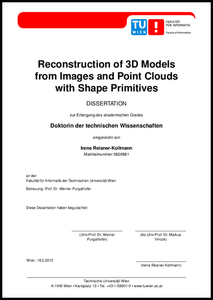Information
- Publication Type: PhD-Thesis
- Workgroup(s)/Project(s):
- Date: February 2013
- Date (Start): January 2010
- Date (End): January 2013
- TU Wien Library:
- 1st Reviewer: Werner Purgathofer
- 2nd Reviewer: Prof. Dr. Markus Vincze
- Rigorosum: 12. March 2013
- First Supervisor: Werner Purgathofer
Abstract
3D models are widely used in different applications, including computer games, planning software, applications for training and simulation, and virtual city maps. For many of these applications it is necessary or at least advantageous, if the virtual 3D models are based on real world scenes and objects. Manual modeling is reserved for experts as it requires extensive skills. For this reason, it is necessary to provide automatic or semi-automatic, easy-to-use techniques for reconstructing 3D objects.In this thesis we present methods for reconstructing 3D models of man-made scenes. These scenes can often be approximated with a set of geometric primitives, like planes or cylinders. Using geometric primitives leads to light-weight, low-poly 3D models, which are beneficial for efficient storage and post-processing.
The applicability of reconstruction algorithms highly depends on the existing input data, the characteristics of the captured objects, and the desired properties of the reconstructed 3D model. For this reason, we present three algorithms that use different input data. It is possible to reconstruct 3D models from just a few photographs or to use a dense point cloud as input. Furthermore, we present techniques to combine information from both, images and point clouds.
The image-based reconstruction method is especially designed for environments with homogenous and reflective surfaces where it is difficult to acquire reliable point sets. Therefore we use an interactive application which requires user input. Shape primitives are fit to user-defined segmentations in two or more images.
Our point-based algorithms, on the other hand, provide fully automatic reconstructions. Nevertheless, the automatic computations can be enhanced by manual user inputs for generating improved results. The first point-based algorithm is specialized on reconstructing 3D models of buildings and uses unstructured point clouds as input. The point cloud is segmented into planar regions and converted into 3D geometry.
The second point-based algorithm additionally supports the reconstruction of interior scenes. While unstructured point clouds are supported as well, this algorithm specifically exploits the redundancy and visibility information provided by a set of range images. The data is automatically segmented into geometric primitives. Then the shape boundaries are extracted either automatically or interactively.
Additional Files and Images
Weblinks
No further information available.BibTeX
@phdthesis{Reisner_Irene_2013_R3D,
title = "Reconstruction of 3D Models from Images and Point Clouds
with Shape Primitives",
author = "Irene Reisner-Kollmann",
year = "2013",
abstract = "3D models are widely used in different applications,
including computer games, planning software, applications
for training and simulation, and virtual city maps. For many
of these applications it is necessary or at least
advantageous, if the virtual 3D models are based on real
world scenes and objects. Manual modeling is reserved for
experts as it requires extensive skills. For this reason, it
is necessary to provide automatic or semi-automatic,
easy-to-use techniques for reconstructing 3D objects. In
this thesis we present methods for reconstructing 3D models
of man-made scenes. These scenes can often be approximated
with a set of geometric primitives, like planes or
cylinders. Using geometric primitives leads to light-weight,
low-poly 3D models, which are beneficial for efficient
storage and post-processing. The applicability of
reconstruction algorithms highly depends on the existing
input data, the characteristics of the captured objects, and
the desired properties of the reconstructed 3D model. For
this reason, we present three algorithms that use different
input data. It is possible to reconstruct 3D models from
just a few photographs or to use a dense point cloud as
input. Furthermore, we present techniques to combine
information from both, images and point clouds. The
image-based reconstruction method is especially designed for
environments with homogenous and reflective surfaces where
it is difficult to acquire reliable point sets. Therefore we
use an interactive application which requires user input.
Shape primitives are fit to user-defined segmentations in
two or more images. Our point-based algorithms, on the
other hand, provide fully automatic reconstructions.
Nevertheless, the automatic computations can be enhanced by
manual user inputs for generating improved results. The
first point-based algorithm is specialized on reconstructing
3D models of buildings and uses unstructured point clouds as
input. The point cloud is segmented into planar regions and
converted into 3D geometry. The second point-based
algorithm additionally supports the reconstruction of
interior scenes. While unstructured point clouds are
supported as well, this algorithm specifically exploits the
redundancy and visibility information provided by a set of
range images. The data is automatically segmented into
geometric primitives. Then the shape boundaries are
extracted either automatically or interactively.",
month = feb,
address = "Favoritenstrasse 9-11/E193-02, A-1040 Vienna, Austria",
school = "Institute of Computer Graphics and Algorithms, Vienna
University of Technology ",
URL = "https://www.cg.tuwien.ac.at/research/publications/2013/Reisner_Irene_2013_R3D/",
}



